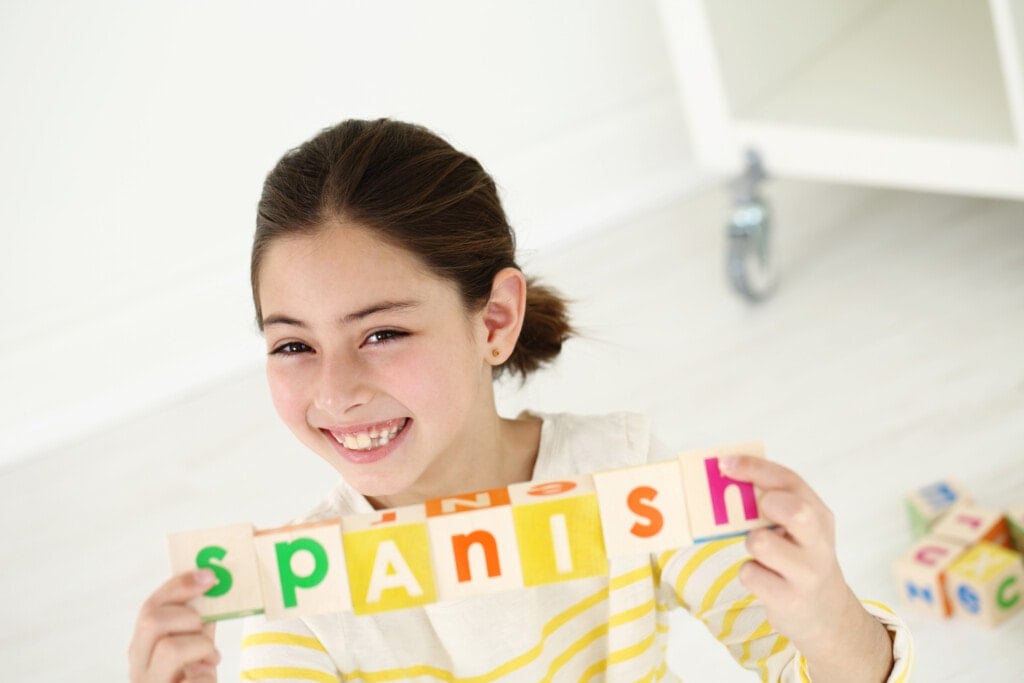Perhaps you have heard that introducing your child to another language will confuse them and cause them to be a late talker. Or maybe you don’t know where to begin to teach your child a new language. It could be that you don’t speak a second language. Perhaps your wonder whether it will be possible for your child to learn a second language.
As a bilingual speech-language pathologist, I frequently hear these concerns. When I work with families, I help them understand the benefits of raising bilingual children. I also help them understand how bilingual development differs from a child learning only one language. Here’s how you can help your child master a second language at any age and in any circumstance.
Benefits of Bilingualism
Besides the obvious advantage of knowing more than one language, there are many social and cognitive benefits for children who learn a second (or third!) language from a young age.
Social
When children learn to speak two languages, one of the first things they do is figure out who speaks which language. In a household where each parent speaks a different language, the child will begin to use different intonation patterns with each parent as early as three months old. The child will eventually use the appropriate language with each parent. As the child gets older, this skill carries over outside the home. The bilingual learner “marks” speakers of different languages.
This skill enables bilingual learners to read social cues better as they alternate between two languages. They also begin to navigate two cultures. The result is children who have greater social flexibility and a distinct set of tools that can help them adapt to different social environments.2
Cognitive
In addition to the social benefits, there are also many cognitive benefits to knowing multiple languages, which can continue into old age. When the child learns two vocabularies, the words are mapped differently in the brain. The bilingual speaker must decide which language to use during conversations and block the other language from interfering.
For example, when a bilingual person speaks, they rely on one language map. This allows them to use the grammar and vocabulary of the language they are speaking, while the other language system gets “shut down.” These skills benefit a person’s executive functioning skills. That is, it becomes easier for a person to plan, problem-solve, and ignore distractions, which makes tasks like puzzles or block designs easier.1
When to Teach Your Child a New Language
With so many advantages to being bilingual, you’re probably wondering when you can start (and if it’s too late for you to learn a new language, too!). The answer is that it’s never too early or too late to begin learning a new language. But younger children can learn a language with greater ease than someone in their thirties.
Babies begin to distinguish between the sounds of different languages in-utero and continue to sort out the sounds of different languages throughout early infancy. Amazingly, newborns can differentiate between the sounds of all languages in the world (600 distinct sounds!) until around six months of age. Then they begin to focus on producing only the sounds of the languages they are exposed to at home.3
Because children have such adaptable brains that are creating new connections all the time, they can learn languages with native fluency until about ten years old. An adult trying to learn a language will have a much more difficult time learning how to map the grammar onto their existing language. But they are certainly capable of learning to communicate in a new language!
Different Models of Language Development
There are many different ways to expose your children to multiple languages, even if you don’t speak the new language yourself (but again, there’s always time to learn!). Exposure does not have to be exactly 50/50 for a child to learn a language. But the child will receive more exposure to the culturally dominant language of the country when watching TV, visiting stores, attending school, etc.
One Parent, One Language
The most common method of bilingual development is “one parent, one language.” This means each parent chooses one language to use with their growing child all the time. There are pros and cons to this method of teaching. One major disadvantage is that it eliminates family conversations if one parent does not speak the new language. A major plus to using this method is that parents have a unique opportunity to bond with their children and introduce them to their culture.
Both Parents, Both Languages
If both parents are speakers of each language, “both parents, both languages” is also effective. Parents who use this teaching method often wonder if exposure is “equal.” In these situations, I suggest choosing daily routines where the dominant language will change each day. For example, Monday, Wednesday, and Friday are Spanish bath times, while Tuesday, Thursday, and Saturday are English bath times.
No Parents Speak the Language
In cases where neither parent speaks the new language, it is still possible for children to get the benefits of learning a new language. Some opportunities for language learning include:
- Nanny/Caregiver who speaks a different language
- Dual language daycare/preschool
- Music class or other enrichment class in the new language
There is no right or wrong way to teach your child a new language. Whichever method you decide is right for your family will benefit your child’s overall development in countless ways. It will also expose them to a new world and culture. That, in and of itself, is a true gift.


































